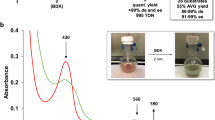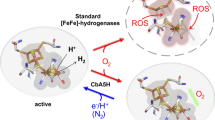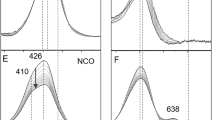Abstract
IN addition to transporting CO2 indirectly by way of the alkaline Bohr effect, haemoglobin can interact directly with CO2 to form carbamate residues : RNH2 + CO2⇌RNHCOO− + H+ This reaction of CO2 with haemoglobin is oxygen-linked so that at constant pH more CO2 is bound to deoxy- than to oxyhaemoglobin, and conversely the oxygen affinity of haemoglobin is decreased in the presence of CO2 (refs 1 and 2). The studies of Kilmartin and Rossi-Bernardi3,4 on horse haemoglobin specifically modified at the N terminal amino groups by reaction with cyanate showed that at constant pH CO2 has no effect on the oxygen affinity of haemoglobin when all four α-amino groups are carbamylated, but that only part of the oxygen-linked effect is inhibited when the α-amino groups of only the α or only the β chains are blocked. This implies that the N-terminal amino groups are solely responsible for the oxygen-linked CO2 interactions and that this effect is shared between the α and β chains. More recent experiments have confirmed these results for human haemoglobin5.
This is a preview of subscription content, access via your institution
Access options
Subscribe to this journal
Receive 51 print issues and online access
$199.00 per year
only $3.90 per issue
Buy this article
- Purchase on Springer Link
- Instant access to full article PDF
Prices may be subject to local taxes which are calculated during checkout
Similar content being viewed by others
References
Rossi-Bernardi, L., and Roughton, F. J. W., J. Physiol. Lond., 189, 1 (1967).
Roughton, F. J. W., Biochem. J., 117, 801 (1970).
Kilmartin, J. V., and Rossi-Bernardi, L., Nature, 222, 1243 (1969).
Kilmartin, J. V., and Rossi-Bernardi, L., Biochem. J., 124, 31 (1971).
Kilmartin, J. V., Fogg, J., Luzzana, M., and Rossi-Bernardi, L., J. biol. Chem. (in the press).
Perutz, M. F., J. Cryst. Growth, 2, 54 (1968).
Muirhead, H., and Greer, J., Nature, 228, 516 (1970).
Arnone, A., Nature, 237, 146 (1972).
Perutz, M. F., New Scient., 50, 762 (1971).
Paniker, N. V., Ben-Bassat, I., and Beutler, E., J. Lab. clin. Med., 80, 282 (1972).
Briehl, R. W., and Ewert, S., J. molec. Biol. (in the press).
Muchlbacher, C., De Bon, F. L., and Featherstone, R. M., Intern. Anesthesiol. Clin., 1, 937 (1963).
Schoenborn, B. P., Nature, 208, 760 (1965).
Author information
Authors and Affiliations
Rights and permissions
About this article
Cite this article
ARNONE, A. X-ray Studies of the Interaction of CO2 with Human Deoxyhaemoglobin. Nature 247, 143–145 (1974). https://doi.org/10.1038/247143a0
Received:
Issue Date:
DOI: https://doi.org/10.1038/247143a0
This article is cited by
-
Comparative effects of CO2 on the affinity for O2 of fetal and adult erythrocytes
Pfl�gers Archiv European Journal of Physiology (1979)
-
Effects of inositol hexaphosphate on the Bohr effect induced by CO2 and fixed acids in chicken hemoglobin
Pfl�gers Archiv European Journal of Physiology (1978)
Comments
By submitting a comment you agree to abide by our Terms and Community Guidelines. If you find something abusive or that does not comply with our terms or guidelines please flag it as inappropriate.



